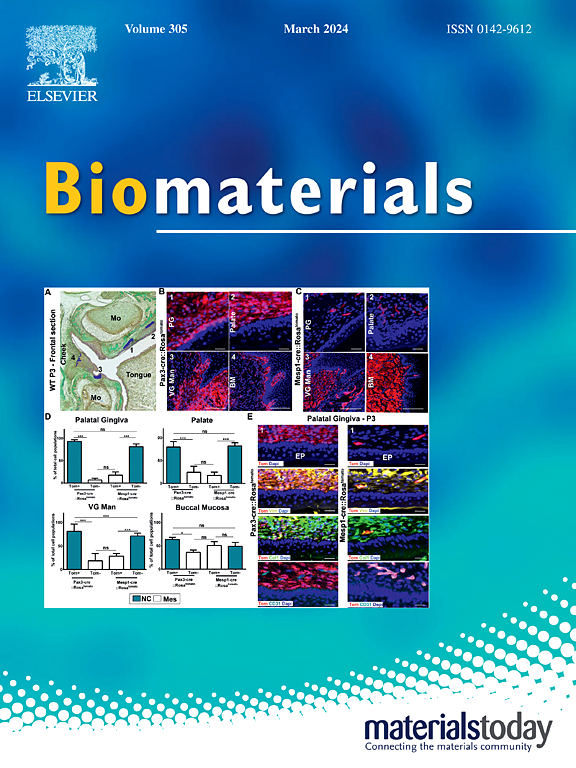Bovine serum albumin framed activatable NIR AIE photosensitizer for targeted tumor therapy
IF 12.8
1区 医学
Q1 ENGINEERING, BIOMEDICAL
引用次数: 0
Abstract
Organic near-infrared (NIR) photosensitizers (PS) largely facilitate photodynamic therapy (PDT). To overcome aggregation induced quenching and diminishment of reactive oxygen species (ROS) generation capability of NIR-PS, aggregation-induced emission (AIE) effect groups have been introduced to generate NIR AIE photosensitizers. However, currently reported NIR AIE photosensitizers all take “always-on” activity that may cause systemic phototoxic side effects. Tumor microenvironment activatable NIR AIE photosensitizers have not been reported. Here we develop an activatable NIR AIE PS nanoparticle (a-NA-PSNP) for near-infrared-II (NIR-II) fluorescence (FL) imaging-guided PDT under 808 nm excitation. NIR AIE photosensitizer (N-PS) is designed and frames with cysteine (Cys)/glutathione (GSH) responsive charge transfer complex (CTC) in bovine serum albumin (BSA) to obtain a-NA-PSNP. With the aggregated state in BSA, N-PS shows high quantum yield with good photostability. As an energy acceptor, CTC quenchs NIR-II fluorescence and ROS production capability of a-NA-PSNP in normal cells and tissues. CTC is decomposed in response to tumor microenvironment Cys/GSH, therefore recovers NIR-II fluorescence of a-NA-PSNP and efficiently generates ROS under 808 nm light irradiation. The depletion of Cys/GSH also regulates tumor intracellular reductive environment to further facilitate PDT. Both in vitro and in vivo results confirmed the tumor microenvironment selective and efficient activation of a-NA-PSNP, indicating its potential in cancer therapy.
用于肿瘤靶向治疗的牛血清白蛋白框架可激活近红外 AIE 光敏剂
有机近红外(NIR)光敏剂(PS)在很大程度上促进了光动力疗法(PDT)。为了克服聚集诱导淬灭和降低近红外光敏剂产生活性氧(ROS)的能力,人们引入了聚集诱导发射(AIE)效应基团来生成近红外 AIE 光敏剂。然而,目前报道的近红外 AIE 光敏剂都具有 "始终开启 "的活性,可能会引起全身光毒性副作用。目前还没有关于可激活肿瘤微环境的近红外 AIE 光敏剂的报道。在此,我们开发了一种可激活的近红外 AIE PS 纳米粒子(a-NA-PSNP),用于 808 纳米激发下的近红外 II(NIR-II)荧光成像(FL)引导的光导放疗。设计了近红外AIE光敏剂(N-PS),并将其与牛血清白蛋白(BSA)中的半胱氨酸(Cys)/谷胱甘肽(GSH)反应性电荷转移复合物(CTC)组装在一起,得到了a-NA-PSNP。通过在 BSA 中的聚集状态,N-PS 显示出较高的量子产率和良好的光稳定性。作为一种能量接受体,四氯化碳可淬灭正常细胞和组织中 a-NA-PSNP 的 NIR-II 荧光和 ROS 生成能力。四氯化碳会随着肿瘤微环境中 Cys/GSH 的分解而分解,从而恢复 a-NA-PSNP 的 NIR-II 荧光,并在 808 纳米光照射下有效地产生 ROS。Cys/GSH 的耗竭还能调节肿瘤细胞内的还原环境,从而进一步促进 PDT。体外和体内研究结果都证实了 a-NA-PSNP 对肿瘤微环境的选择性和高效活化作用,显示了它在癌症治疗中的潜力。
本文章由计算机程序翻译,如有差异,请以英文原文为准。
求助全文
约1分钟内获得全文
求助全文
来源期刊

Biomaterials
工程技术-材料科学:生物材料
CiteScore
26.00
自引率
2.90%
发文量
565
审稿时长
46 days
期刊介绍:
Biomaterials is an international journal covering the science and clinical application of biomaterials. A biomaterial is now defined as a substance that has been engineered to take a form which, alone or as part of a complex system, is used to direct, by control of interactions with components of living systems, the course of any therapeutic or diagnostic procedure. It is the aim of the journal to provide a peer-reviewed forum for the publication of original papers and authoritative review and opinion papers dealing with the most important issues facing the use of biomaterials in clinical practice. The scope of the journal covers the wide range of physical, biological and chemical sciences that underpin the design of biomaterials and the clinical disciplines in which they are used. These sciences include polymer synthesis and characterization, drug and gene vector design, the biology of the host response, immunology and toxicology and self assembly at the nanoscale. Clinical applications include the therapies of medical technology and regenerative medicine in all clinical disciplines, and diagnostic systems that reply on innovative contrast and sensing agents. The journal is relevant to areas such as cancer diagnosis and therapy, implantable devices, drug delivery systems, gene vectors, bionanotechnology and tissue engineering.
 求助内容:
求助内容: 应助结果提醒方式:
应助结果提醒方式:


